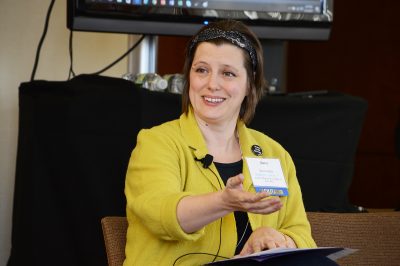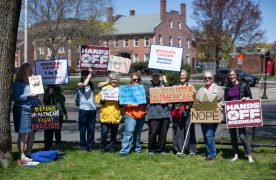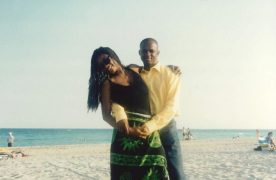 About 50 educators, performers, artists and disabled dancers from AXIS Dance Company participated in a panel discussion that was geared toward exploring issues surrounding artists with disabilities in the performing arts on Monday at Boston University’s Florence and Chafetz Hillel House.
About 50 educators, performers, artists and disabled dancers from AXIS Dance Company participated in a panel discussion that was geared toward exploring issues surrounding artists with disabilities in the performing arts on Monday at Boston University’s Florence and Chafetz Hillel House.
The panelists focused on resources, advocacy, progress and next steps in advancing the inclusion of artists with disabilities. The panel was part of a larger symposium aimed at exploring more opportunities for artists with disabilities. After the panel discussion, the audience was divided into groups with different themes to continue breakout sessions, such as leadership, training and activism.
The panelists in the discussion included Judith Smith, founder and director of AXIS Dance company; Keith Jones, president and CEO of SoulTouchin’ Experiences; Yo-el Cassell, a professor at BU’s College of Fine Arts; John Killacky, executive director and CEO of the Flynn Center for the Performing Arts and actress Beth Peters.
Jones said “desire and passion for the performing arts” are the biggest teachers for artists.
“The desire to become a real artist is the motivation of our professional learning,” Jones said during the panel discussion. “For instance, I have to learn to play the piano with my left foot, because no one can professionally teach you how to play the piano with [your] left foot.”
Jones had to learn how to play the piano with his left foot because he lost his feeling in his hands.
“We deeply hope that teachers can treat us as a normal student who have the ability to learn performing arts,” Jones said. “It is time to erase the prejudices and biased opinions for the artists with disabilities. Although I clearly know that our performances are mostly viewed as miracles for most of our audience, I still wanna be treated as just a normal dancer.”
Smith said she started her dance career “accidentally.” She is a also a paraplegic dancer with AXIS.
“I learn the dance by myself, basically, and the way we learn to dance is to watch every dance performances and read anything about dancing and learn, imitate from it,” she said. “For myself, I love the way of expressing the art through my wheels. I love moving fast with my wheels.”
Killacky said being an artist without the sensibility of the left side of his body creates unique challenges.
“I remembered once I fell over from my wheels, some students there just watched me and no one came for help,” Killacky said. “We gather together today to make the community to see our needs and wishes.”
Several people who attended the discussion said it would be beneficial for those who aren’t as knowledgeable about artists living with disabilities.
Dwayne Scheuneman, a dance teacher for AXIS, also teaches a dance class in BU’s CFA.
“People who have participated in our dancing class have shown great interest and the dance integration is the main content [we’re] gonna teach the students here,” Scheuneman said. “This panel discussion will be a great chance for people from different fields to know about how artists like us [with disabilities] perform the dance or get training. For us, we can broaden our performing opportunities through this symposium.”
Betsy Katz, a professor of performing dance therapy at Lesley University, also attended the panel discussion.
“The panel discussion is really effective and many encouraging ideas of the discussion are worth sharing with my students at Lesley University,” Katz said. “A panel discussion is a great opportunity to learn about dance training for disabled people.”
Charles Washburn, the vice president of VSA Massachusetts, helped organize and sponsor the symposium.
“The purpose of holding the panel discussion is to improve accessibility of performing arts with disabilities for the whole community,” Washburn said. “It is a great chance to make the miracle of art spreading widely in Boston.”












